
Beginner one-piece
.pdf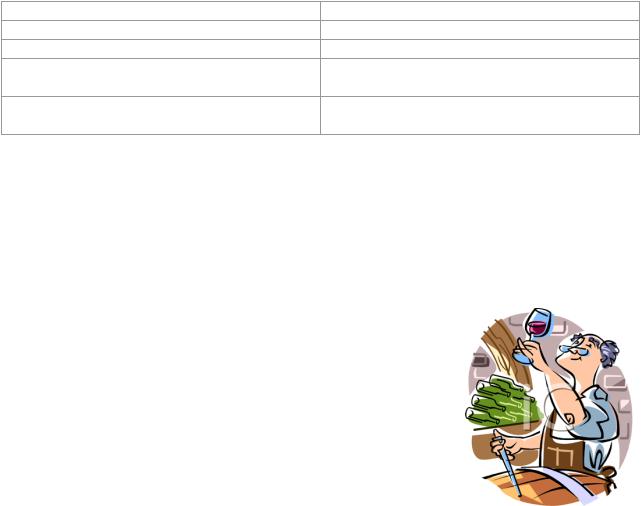
forefather |
невичерпний |
ready for self-sacrifice |
народні обряди |
passion |
спадщина |
inexhaustible |
предок |
heritage |
доказ |
folk rites |
готовийнасамопожертву |
consideration |
розсудливість |
b.Think and comment using the text information.
1.Prove that Ukrainians are the original inhabitants of Ukraine.
2.How was Ukrainian mentality formed?
3.Describe Ukrainians as a nation.
4.What do Ukrainians value most of all?
5.Name the most characteristic features of Ukrainians.
6.Check the information about Crimea and look through activities offered.
Two thousand years ago, Crimea was an agricultural area and
exported grain to ancient Greece. Today, it still produces a million tons of grain a year, along with sunflower oil and other agricultural products for export. Vineyards like those as Massandra in the South and Koktebel in the East produce grapes for famous wines exported by Ukraine throughout Eastern Europe. Many Crimeans work in the seasonal tourist trade, in the numerous sanatoria on the south coast. Built from the 19th century onward, they are in fact hotels, most with private beaches. The name ‘sanatoria’ comes from these resorts’ long tradition as health spas. 100 years ago, people came to Crimea in the hope that the sea air would help them recover from a variety of illnesses.
Today, many of the sanatoria offer the full range of health and fitness treatments – massage, mudbaths, fitness and weight loss programmes, saunas and so on. Also, the Crimean landscape allows one to enjoy a number of exciting outdoors activities.
a.Find a word in the article to complete the phrase.
Agricultural ……….; to export ………. ; sunflower ………. ; famous wines ………. exported by; to work in the seasonal ………. ………. ; ………. coast; ………. beaches; health ………. ; a variety of ………. ; a full range of ………. … ………. ………. ; ………. outdoor activities.
b. Tell the class about Crimea under the headlines: Position, Nature, History, Industries, Holiday activities.
7. Study the text about Ukrainian fairy tales and check the activities.
Ukrainian fairy tales are as old as the hills. For centuries, people have been gathering stories and integrating life experience, dreams, facts and fiction into them. They told tales to their children to teach them how to be good.
Many popular tales are about animals. Rukavychka – The Fly’s Castle – is about seven animals, from a mouse to a bear, who make their home inside a lose mitten and become friends. In the story Koza-Dereza, the main character is Billy Goat Gruff who tells lies and is punished for that.
Other fairy tales deal with magic. Their good character fight against the evil ones. Kotygoroshko –Thistledown – saves the older brothers from the Dragon’s dungeon. The story of Tsarivna-Zhaba in which Prince Ivan marries a frog and helps her to become a beautiful princess is also famous.
Some tales are about every day life. Their good characters are hard-working, generous and wise. They defeat the bad ones.
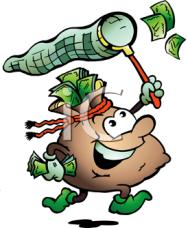
All Ukrainian fairy tales are full of humour, love to nature and to our native land. There is something for everyone in them. Which is your favourite?
a. Match the Ukrainian and English titles of fairy tales.
1. |
Kotygoroshko |
a. The Frog Princess |
2. |
Rukavychka |
b. The Billy Goat Gruff |
3. |
Koza-Dereza |
c. Thistledown |
4. |
Tsarivna-Zhaba |
d. The Fly’s Castle |
b.Read the text again and for fairy tales 1-4 in ex. a write out all the adjectives used to describe the main character and add your own.
A………………………………………………
B………………………………………………
C………………………………………………
D………………………………………………
c.Explain the words from the text in bold.
d.Use the gestures to describe characters from Ukrainian fairy tales. Your class guesses which character you’re describing.
8.Read the following information about Ukrainian hryvnia and do the activities.
A currency called hryvna was used in Kievan Rus. In 1917, after the Ukrainian National
Republic declared independence from the Russian Empire, the name of the new Ukrainian currency became hryvnia, a revised version of the Kievan Rus’ hryvna. The designer was Heorhiy Narbut.
The hryvnia replaced the karbovanets during the period of September 2–16, 1996 (1 hryvnia = 100,000 karbovantsiv) due to hyperinflation in the early 1990s as the reason of collapse of the USSR.
To a large extent, the introduction of hryvnia was secretive. Hryvnia was introduced according to President’s Decree dated August 26, 1996. During the transition period, both hryvnia and karbovanets were used in circulation, but merchants were required to give change only in hryvnias. All bank accounts were converted to hryvnia automatically. During the transition period, 97% of karbovanets were taken out of circulation, including 56% in the first 5 days of the currency reform. After September 16, 1996 the remaining karbovanets were allowed to be exchanged to hryvnias in banks.
The hryvnia sign is a cursive Ukrainian letter He, with a double horizontal stroke, symbolizing stability,€. Thesimilarsigntowasthat used in other currency symbols such as ¥ or
released in 2005. It is now supported by the latest computer systems. It is still rarely used in Ukraine; instead, the abbreviation UAH is preferred.
In 1996, the first series of hryvnia banknotes was introduced into circulation by the National Bank of Ukraine. They were dated 1992 and were in denominations of 1, 2, 5, 10 and 20 hryven’. The design of the banknotes was developed by Ukrainian artists Vasyl Lopata and Borys Maksymov. One hryvnya banknotes were printed by the Canadian Bank Note Company in 1992. Two, five and ten hryvnya banknotes were printed two years later. Until introduction into circulation the banknotes were kept in Canada. Also in 1996, the 1, 50, and 100 hryvnia notes of the second series were introduced, with 1 hryvnia dated 1994. Later, highest denominations were added. The 200 hryvnia notes of the second series were introduced in 2001, followed by the 500 hryvnia notes of the third series in 2006.
a. Fill in the blanks using your knowledge on Ukrainian national currency or check the Internet.

Banknote value |
Image description |
Main color |
Year of issue |
|
|
Obverse |
Reverse |
|
|
1 hryvnia |
Vladimir I of |
Ruins of |
Green and brown |
September 2, |
|
Kyiv |
Chersoneses |
|
1996 |
b. Online investigation.
Using the Internet try to find out the origin of other world currencies.
9. Writing options. Try to make a story on the offered topics.
1.Are you a patriot of your country?
2.What is special about your country?
3.Would you like to live abroad? Give your grounds.
4.How do you see Ukraine growing in the next 10-20 years?
5.Is Ukraine worth visiting? Give your reasons.
HUMOUR TIME
Ukrainian people are famous for their ability to find the way out of difficult situations. But they are even more famous for their ability to find the way to get into them.
*****
I handed the conductor 50 kopeks on Ternopil trolley. She took it and turned away. “Where’s my change?” I said. “Haven’t got any,” she said. “You’ll have to ride two more stops.”
*****
The soul of the man is in his stomach
A Ukrainian man was shipwrecked. He lived on a desert island for two years. Once he saw a boat with a beautiful woman not far from the shore. She said: “Come here, and I will give you what you wanted for the last two years”. “Vareniki! Vareniki!” – the man cried and jumped into the water.
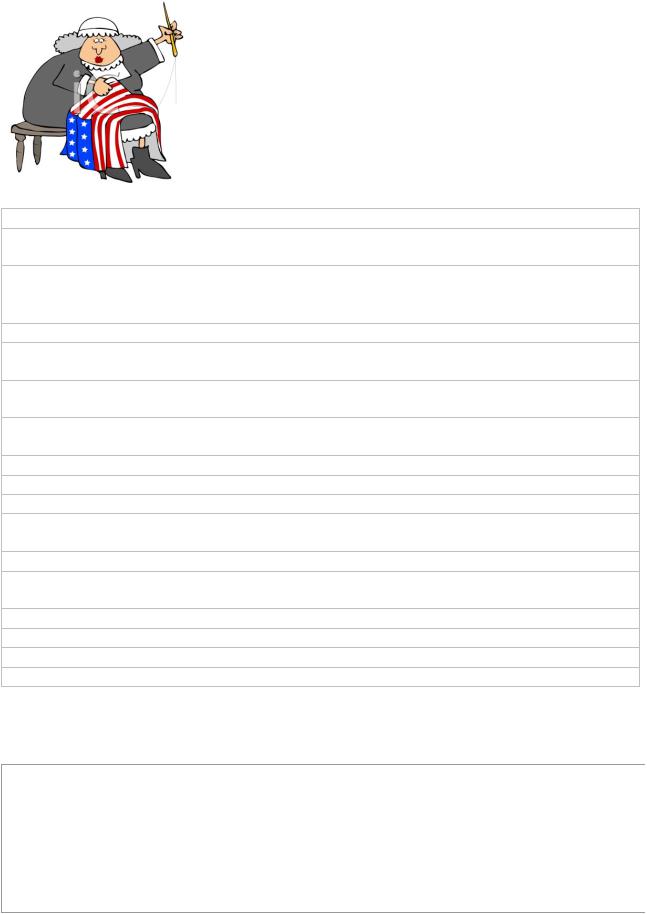
LESSON 16
English-Speaking Countries
Language is a dress of thought.
Language is fossil poetry.
A new language – a new world.
So many languages you know, so times you are a man.
TOPICAL VOCABULARY |
|
|
1. General |
1. Загальна лексика |
|
native language (mother tongue) / foreign |
ріднамоваіноземна/ моваміжнародна/ мова |
|
language / international language |
|
|
English-speaking country |
англомовнакраїна |
|
to study(ied) / to learn(ed / t) / to teach |
вивч/ на/итивч/ напамити |
’ять |
(taught; taught) / to learn by heart |
|
|
native speaker |
носіймови |
|
knowledge / thorough knowledge (good |
знаннядобре/ володінняанглійськоюмовою |
|
command) of English |
|
|
to speak poor English / to speak fluently |
поганорозмовлятианглійсь |
кою / розмовляти |
|
вільно |
|
to have a good command of / to master(ed) |
оволодітимовою |
|
the language |
|
|
vocabulary |
лексика |
|
foreign accent |
іноземнийакцент |
|
means of communication |
засібспілкування |
|
to read (read; read) in the original / in |
читати воригіналіу/перекладі |
|
translation |
|
|
language peculiarity |
особливість мови |
|
to translate(d) / to interpret(ed) / to translate |
перекладатиписьмовоперекладати/ усно/ |
|
with a dictionary / translator (interpreter) |
перекладатизісловником |
/перекладач |
meaning / to mean (meant; meant) |
значенняозначати/ |
|
to do (did; done) one’s best |
робитивсеможливе |
|
to be of great importance |
мативажливезначення |
|
as quick as possible |
якомогашвидше |
|
INTRODUCTORY TEXT |
|
|
English-speaking Countries |
|
|
Notes to the text: |
|
|
bald eagle – білоголовий орлан |
to stay(ed) in close association with – |
|
dense (population) – щільний,густий |
залишитися в тіспнівпрацій |
|
(густонаселений ) |
the Commonwealth of Nations – |
|
beaver – бобер |
Співдружність націй |
|
maple leaf – кленовий лист |
edging – кайма |
|
urban areas – міські райони |
dominion – панування |
|
banner – прапор |
flightless bird kiwi – нелітаючий птах ківі |
|
the Southern Cross constellation – сузір’я |
silver fern – срібна папороть |
|

 Південного Хреста
Південного Хреста
Except the United Kingdom there are some other countries in the world where people speak English and this language is one of the official ones. The largest and most important of them are the USA, Canada, Australia and New Zealand.
The USA has 50 states. The flag of the USA has 13 red and white stripes, which symbolize the original 13 states. The national symbol of America is the bald eagle; another one is Uncle Sam. 50 stars on the blue field in the left upper corner are for each of the 50 states of the country in our days. The capital of the USA is Washington, D.C. (the District of Columbia). This city was named in honour of the first US president. People of various nationalities live in the USA: the English, the German, the Chinese, the Hindu, the Greek and so on.
The world’s second-largest country is Canada. Though Canada is one of largest countries in the world, its population isn’t dense. Canada has two official languages – English and French, both spoken by its citizens. The leading cities of Canada are Toronto, Montreal and Vancouver. The capital of Canada is Ottawa. The official head of Canada is the Queen of the United Kingdom. But practically there is a Prime Minister of the Canadian government to rule the country. Emblems of Canada are the beaver and the maple leaf. The colours of Canada are white and red.
Australia – a continent and a state – is situated in the Southern Hemisphere, in the southern part of Asia, between the Pacific and Indian oceans. It is about 8 million square kilometres. Australia occupies the Tasmania Island and a number of smaller islands too. It is divided into 8 administrative areas. People of about 200 nationalities live there. The aborigines, the Australian natives, represent about 1.5 percent of the population. The Australian flag is blue. There is the flag of the UK on the Australian banner, a large seven-pointed star beneath it and the Southern Cross constellation.
Another country in the Pacific Ocean where people speak English as an official language is New Zealand. It is located not far from Australia – only the Tasman Sea separates them by a distance of about 1,600 km. New Zealand is a constitutional monarchy with a parliamentary form of government.
New Zealand stays in close association with the United Kingdom as a member of the Commonwealth of Nations. And the formal head of the state is the Queen of the United Kingdom. The New Zealand flag represents the Southern Cross, the stars of it are red with white edgings. The flag of the United Kingdom in the left upper corner shows the recognition to the historical foundations and the fact that New Zealand was once a British colony and dominion. The national emblem of New Zealand is a flightless bird kiwi. And silver fern is a sporting emblem.
1.Comprehension questions.
1.Where is English spoken as an official language?
2.What English-speaking country has 2 official languages? What are they?
3.What are emblems of Canada?
4.What is depicted on Australian flag?
5.What country is situated between the Pacific and Indian oceans?
6.How can you prove that New Zealand was once a British colony and dominion?
7.What is the national emblem of New Zealand?
2.Find in the text English equivalents to the following.
Офіцмова,різйнаоманітніціональності,густонаселений,багатонаціональне суспільство,семикутназірка,парламентськафо ма,авлінняофіційн ийголова,символ спорту,визнанняісторичногозаснування.
VOCABULARY PRACTICE
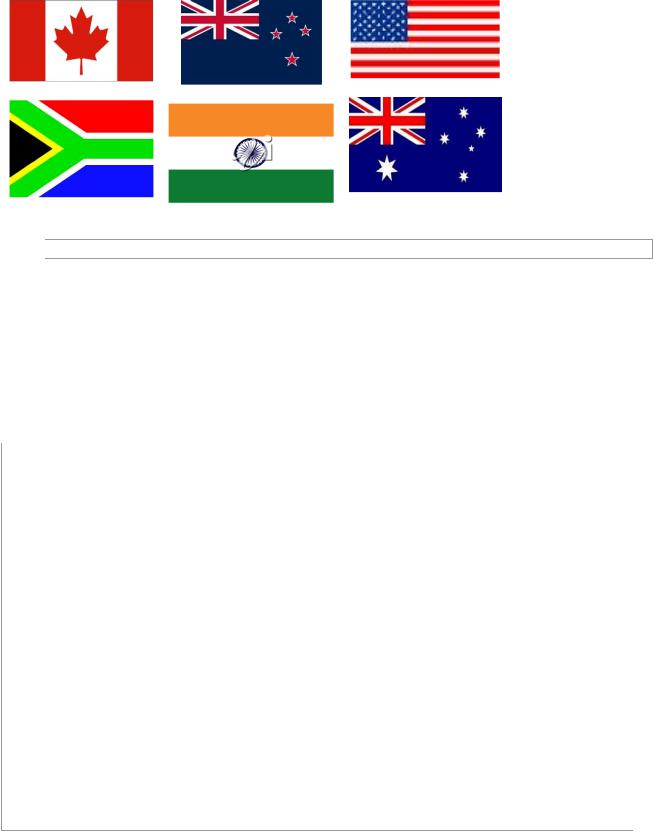
1.These flags all belong to English-speaking countries. Match the name of the country with its flag.
The United States
Canada
Australia
New Zealand
South Africa
India
2. Choose one of the verbs in the box and put it in the right form. try, leave, be, open
1.English ………. the global language of communication in all major fields today.
2.Many books, magazines, and newspapers written in English ………. available in many countries around the world.
3.Knowledge of English ………. new world of culture, business and travel opportunities.
4.Students ………. to do their best to master English.
5.English, the language of the people who ………. England to make their names in new countries.
3.How much do you know about the USA? Match the columns. Write the correct letters on the lines.
1._____ Flag Day
2._____ fifty
3._____ thirteen
4._____ flag
5._____ holiday
6._____ June
7._____ Pledge of Allegiance
8._____ salute
9._____ Old Glory
10._____ stand at attention
11._____ patriotism
12._____ flag pole
13._____ red, white, blue
14._____ respect
15._____ fly the flag
16._____ sunrise to sunset
17._____ Raise the flag ____.
18._____ Lower the flag ____.
19._____ triangle
20._____ American national anthem
a.a promise of loyalty to U.S.
b.admiration, honor
c.banner that represents a country
d.colors of the American flag
e.display the flag
f.holiday to honor the flag
g.love for one’s country
h.month Flag Day is in
i.nickname of the U.S. flag
j.number of stars on U.S. flag
k.number of stripes on U.S. flag
l.proper hours to fly the flag
m.quickly
n.right hand raised to forehead
o.shape of flag when folded
p.slowly
q.special day of the year
r.stand still and remain silent
s.Star-Spangled Banner
t.tall round metal column
4. In each of the following sets of words, one is misspelled. Write that word correctly in the space provided at the left.
__________________ 1. beautyful amateur criticize heroes
__________________ 2. pursue admittance writting seize
__________________ 3. audience athelete possession difference
__________________ 4. privilege villain argument paralize
__________________ 5. efficient ignorance definately exercise
__________________ 6. performence unusually genius leisure
__________________ 7. trans ferred noticeable aggravate guidence
__________________ 8. brilliance beleive conscientious accustom
__________________ 9. apologized committee similiar interest
__________________ 10. magnificent priviledge sufficient changeable
5. Read the following dialogues.
George: Donna, you speak English so fluently. I know English just a little bit and I want to improve it.
Donna: Thanks. This summer I’ve been in the UK as a student on the Intensive Course for English Language Development.
G.: I’ve thought about it also. Tell me about these courses.
D.: It’s the Summer Study Program. You can study for four or eight weeks and create a program of study which suits your own learning needs.
G.: Who can study there?
D.: All students over 18 years of age with intermediate or advanced English level. G.: What are the aims of these courses?
D.: It’s the possibility to improve your English language skills.
*****
A: Victor, you speak good English.
V: Oh, no. My English is rather poor. But I would like to improve my spoken English. A: And how long have you been learning it?
V:Well, normally we study foreign languages at secondary schools starting from the 5th form. In addition to ordinary schools there are specialized English language schools where the
language is taught thoroughly from the first form. Then we continue to study foreign languages in higher educational institutions.
A: What foreign languages are usually taught in your University?
V: As a matter of fact? English, German, French and Spanish. But the majority of students master English. Andrew, and what languages are taught in Universities of Great Britain?
A: Well, we learn French and German as foreign languages. And how many classes a week have you got?
V: We have got an academic hour a week now. It’s too small for languages, but I try to work at English on my own.
A: And what are you doing on your own?
V:I have got a teach-yourself book and some CDs. So now and then I listen to CDs, learn texts and dialogues by heart. I like to read English books in the original. This is the book I am
reading at the moment.
A: And what kinds of books do you prefer to read?
V:I prefer to read fiction, science fiction, adventure and historical books.
6.Fill in the blanks with suitable words. More than one variant may be possible.
English spelling
English spelling is unpredictable at the best of times, and occasionally totally chaotic – an opinion no doubt shared by British ………. and by foreigners who study English. However, studies of the ………. show that there are only about 400 ………. whose spelling is totally irregular. Unfortunately many of them are ………. the most frequently used in the language. The first problem with ………. arose when the Romans tried to write down Old English words
………. the 23 letter Latin alphabet. Old English at that time ………. nearly 40 vowels and consonants. Another problem came with the Norman ………. and the third with the introduction
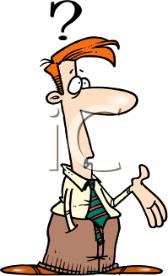
of the printing press in 1476 and emerging of a standard spelling system. The ………. reflected the speech of the London area. During the 15th ………. the pronunciation of vowels changed but because of the printing ………. the standard spelling system never caught up with the ………. . There have been many attempts to reform the ………. spelling system but so far no changes have been made since the 16th century, mainly ………. nobody can agree on what the best alternative may be!
7. Get some information of the English language and express your thoughts.
English language statistics
English is currently one of the most widely spoken and written languages worldwide, with some 380 million native speakers.
Through the global influence of native English speakers in cinema, music, broadcasting, science, and the Internet in recent decades, English is now the most widely learned second language in the world.
Because a working knowledge of English is required in many fields and occupations, education ministries around the world mandate the teaching of English to at least a basic level.
And there are some other facts about English you might be interested in knowing. In no particular order, here are some of the numbers about English:
English is the most widespread language in the world and is more widely spoken and written than any other language.
Over 400 million people use the English vocabulary as a mother tongue, only surpassed in numbers, but not in distribution by speakers of the many varieties of Chinese.
Over 700 million people, speak English, as a foreign language.
Did you know that of all the world’s languages (over 2,700) English is arguably the richest in vocabulary; and that the Oxford English Dictionary lists about 500,000 words, and there are a half-million technical and scientific terms still uncatalogued.
Three-quarters of the world’s mail, telexes and cables are in English.
More than half of the world’s technical and scientific periodicals are in English
English is the medium for 80% of the information stored in the world’s computers
English is the language of navigation, aviation and of Christianity; it is the ecumenical language of the World Council of Churches
Five of the largest broadcasting companies in the world (CBS, NBC, ABC, BBC and CBC) transmit in English, reaching millions and millions of people all over the world. The main language used throughout the world on the internet is English. The media that
make up the Internet are overwhelmingly American in origin, so it is no wonder that the mother tongue of the Web is English. Four factors determine the degree to which a given language finds use on the Internet:
1.The number of users of the language;
2.The extent of its use as an official language;
3.The economic power of the language and ;
4.The volume of information disseminated in that language.
Today, English reigns supreme in all four respects. It is studied as a foreign language throughout the world and employed by a majority of Internet users. Of the 163 member nations of the U.N., more use English as their official language than any other. The easiest way to calculate the economic influence of a language may be to add up the gross domestic products (GDP) of all the nations where it is spoken. People who count English as their mother tongue
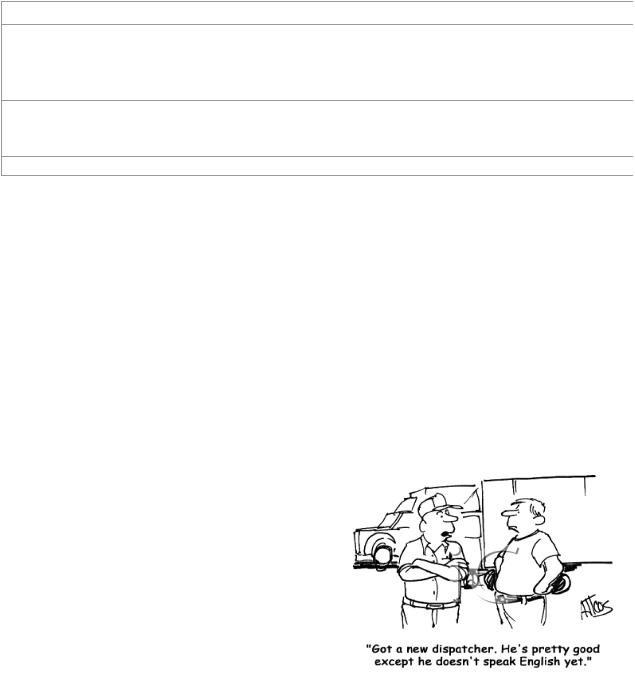
make up less than 10% of the world's population, but possess over 30% of the world’s economic power. Therefore, in terms of the quantity of transmitted information, English is the leader by far. After English, 26 nations in the U.N. cite French as their official tongue, 21 Spanish and 17 Arabic. Each of these three languages forms a sizable linguistic constituency on the Internet.
Decide which of the following statements are true or false.
T / F |
Statements |
|
English is one of the most widely spoken languages worldwide, with some 500 million |
|
native speakers. |
|
English is now the most widely learned second language in the world. |
|
The Oxford English Dictionary lists about 500,000 words. |
|
Three-quarters of the world’s mail, telexes and cables are in French. |
|
People who count English as their mother tongue make up less than 21% of the world’s |
|
population. |
|
English is the medium for 80% of the information stored in the world’s computers. |
8. Writing options. Try to make a story on the offered topics.
1.Can you give at least 5 reasons why people learn foreign languages? Why do you think some people don’t want to learn foreign languages?
2.What do people need to be good language learners?
3.How do you use the Internet to learn English?
4.What foreign languages would you like to know? Why?
5.How do you plan to use the foreign languages you are learning now in your future job?
6.What do you think changes more with time: grammar, vocabulary or pronunciation?
7.Which country is the best place to study English?
8.Do you agree that all the languages are interesting and beautiful in their own way? Why do you think so?
9.Do you think that English will completely dominate all the other languages in future? If yes, how will it affect the world?
HUMOUR TIME
Teacher: Maria please point to America on the map.
Maria: This is it.
Teacher: Well done. Now class, who found America?
Class: Maria did.
*****
A Scotsman who was driving home one night, ran into a car driven by an Englishman. The Scotsman got out of the car to apologize and offered the Englishman a drink of whisky. The Englishman was glad to have it. “Go on,” said the Scot, “have another drink.”
*****
The Englishman drank gratefully. “But don’t you want one, too?” he asked the Scotsman. ”Perhaps,” replied the Scotsman, “after the police have gone.”
*****
Teacher: Tell me a sentence that starts with an “I”. Student: I is the...
Teacher: Stop! Never put “is” after an “I”. Always put ‘am’ after an “I”. Student: OK. I am the ninth letter of the alphabet.
*****
A student, who is studying English as a foreign language, was confused when he saw the words “open here” on a box of laundry soap, so he asks the clerk, “Can’t I wait until I get home to open it?”
